20 23 22 20 K N O W L E D G E E X C H A N G E
20 22 20 23 JUST SPACE - UCL K N O W L E D G E E X C H A N G E

The 2022-2023 Just Space-BSP/UCL Knowledge Exchange programme was led and coordinated by Richard Lee and Robin Brown (Just Space) alongside Michael Edwards, Daniel Fitzpatrick, and Pablo Sendra (Bartlett School of Planning, UCL).
Many thanks goes to Just Space along with the community organisations who participated in the programme, as well as around 80 Bartlett students who participated from UCL.
And a big thank you goes to the Bartlett School of Planning for their support institutionally and financially for this programme, which is extra-curricular in nature but complementary to the students’ planning studies. We believe it is an important component of the training of the future generation of planners and urban designers. It is also an important link between the Bartlett School of Planning and the enormous wealth of community-based knowledge and planning activity happening across London at many different scales and on relevant planning issues by many community and citizen groups.
2022-2023 Just Space-UCL Knowledge Exchange programme Students Booklet
The Bartlett School of Planning, UCL
Graphic design: Irene Manzini Ceinar
Copyeditor: Isaiah Fleming-Klink
Cover design: Irene Manzini Ceinar
JUST SPACE-UCL KNOWLEDGE EXCHANGE 2022-2023 PROGRAMME
A collaboration between: JUST SPACE // Bartlett School of Planning, University College London
The Bartlett School of Planning, UCL
2022/2023
Publication date: March 2024
1. Introduction
2. Protocol
3. Part I: Knowledge Exchange Projects
Deptford
Alton Action
Thames Life
Care Commons
Hackney Local Economy
Recovery Plan
4. Part II: Knowledge Exchange Modules
Morning Lane People’s Space (MOPS)
Strategic Planning Civic
5.
1 Programme Booklet 2022-2023 CONTENT
Design
Conclusion: Programme Learnings Sources 3 7 11 25 41 45
2 Just Space-UCL Knowledge Exchange
INTRODUCTION: THE JUST SPACE-UCL KNOWLEDGE EXCHANGE PROGRAMME
The Bartlett School of Planning has collaborated for many years with Just Space, which is an informal alliance of around 80+ community groups, campaigns and concerned independent organisations, originally formed to act as a voice for Londoners at a grass-roots level during the formulation of the London Plan, London’s major planning strategy.
The emphasis on collaboration has shifted away from volunteerism to knowledge exchange emphasising the exchange that occurs during collaboration between community-led organisations and UCL students. The aim is that knowledge is exchanged between students working on planning courses at the Bartlett and community groups working on planning issues across London who need support with particular planning challenges with research, campaigning and/or advocacy and that students equally learn from the cooperation.
In 2022-2023, the Knowledge Exchange Programme took place in two main ways: through Projects and through Modules. Through Knowledge Exchange Projects, Bartlett students contributed to the work of Just Space or community organisations in the Just Space network, as well as contributing to the ongoing development of community responses to the London Plan and other local Plans and consultations.
The current main document driving these community responses is the Just Space Community-led Recovery Plan, which was developed as a blueprint to feed into the next iteration of the London Plan-making consultations.
The current London Plan came into force in 2021 but started its life in 2016 when Sadiq Khan was elected Mayor. The process of developing a new Plan is due to start in 2024, so this collaboration is timely.
3 Programme Booklet 2022-2023
1
In 2022-2023, the duration of engagement across Projects and Modules varied according to scope of work. In some cases (Deptford) engagement was just a few weeks, while in others (Barking Riverside - Thames Life) it lasted almost the whole academic year.
In the second mode, Knowledge Exchange Modules, Bartlett students engaged with Just Space community organisations over an academic term through a module. While the fundamentals of this engagement were quite similar to those of Projects – learning from communitybased organisations in London while contributing to that organisation’s work by leveraging the knowledge, skills, and resources of both individual students and UCL as an institution – the structure of engagement was shaped more formally by the contours of an academic term and module (i.e. weekly learning, assessments, etc.).
The Knowledge Exchange therefore gave Bartlett students exposure to the quotidian experience of, and struggles with, 21st century planning in London. At the same time, it opened an avenue through which Just Space network organisations could benefit from the energy, knowledge, and resources brought to bear by UCL student participants.
4 Just Space-UCL Knowledge Exchange


5 Programme Booklet 2022-2023 2016 2019 2022
6 Just Space-UCL Knowledge Exchange
2
JUST SPACE KNOWLEDGE EXCHANGE PROTOCOL
The knowledge exchange has worked under the research protocol developed by Just Space and formalised in 2018. This had grown out of experiences of interactions between researchers and local action groups in London, and out of the strongly felt need that these collaborations should be more extensive, but also that they should be more productive for both parties than they often are. While such collaborations can be very positive, there are pitfalls to be avoided. The protocol was developed to ensure good outcomes when carrying out research and fieldwork projects which answer to the needs of the whole society and in particular of economically weaker groups, whose experiences often have little impact on research agendas.
The other aspect which we realised was important with the knowledge exchange was to create a space for urban and planning research where we can move beyond the current increasing drivers of urban policy, which increasingly is based on market
forces, the power of real estate and financial interests influencing governments and local authorities. This has extended into areas such as social housing, recreational provision, elder care etc— and increases inequalities of income and wealth, undermines the rights of local communities and underplays the importance of environmental protection and sustainability. The same forces which have so influenced urban policy increasingly also influence the content of research and education.
The Knowledge Exchange therefore has become a space where the students and indeed university can provide critical and challenging analysis and creative thinking and thus help widen public debate and develop alternatives. Community and action groups working on planning issues are normally under-resourced in their engagements with local authority planning departments and developers.
7 Programme Booklet 2022-2023
Furthermore, much expertise is to be found among activists and community members. The input and support from researchers can be vital but also, but the very same students can learn much from these perspectives too.
With larger scale and metropolitanwide planning issues, local knowledge is rarely valued, and yet a community perspective is still essential. The experience of the Just Space network with the London Plan Examination in Public process exemplifies this, where the need to develop wide-ranging and often technical responses to planning issues and to present more synthetic evidence offers an opening for supportive research interventions.
The Knowledge Exchange has acknowledged how under-resourced citizen groups and campaigns can be, and have approached groups with this in mind. Early research into groups and their activities, as well as early consultation into the formulation of briefs and topics
with community groups has been important. Developing a collaborative relationship has opened up spaces for both practical as well as theoretical discussions, for innovative thinking and for creative tension as well as practical support and impact. The Knowledge Exchange has fostered relationships between community groups and students at BSP, where time and effort have been reciprocally given.
From the perspective of community groups, they have made an invaluable contribution to the education and training of the next generation of planners and urban designers. Some considerations have been important such as the clear formulation of what their group has wanted from the relationship and responding to the timescale the students have had.
Even when short timescales have been imposed, these have developed into longer projects with different cohorts of students.
8 Just Space-UCL Knowledge Exchange
process is a divisive issue amongst resident mbers,
enhanced by the offers given to
he problem of
diffe
a housing shortage in London
Agreements of what could be given in return – in money and practical help have been important as we integrate into the yearly budgets clear expectations of what groups need in exchange for their time and effort.
From the students’ perspective the best advice has been:
eant to suggest that residents should vote a ocess, but rather to try and make the proces
also drawing attention to the wider system t
Be prepared to contribute time and effort to the group which might not directly feed into your research process but reciprocates the contribution which the group are making to your research. Do the washing up & put the chairs away.
Civic Design Project, Group 6 Members of the research group gathered insights from residents on the canvases during the Civic Design Workshop

Programme Booklet 2022-2023
esearch ts on th
10 Just Space-UCL Knowledge Exchange
PART I: KNOWLEDGE EXCHANGE PROJECTS 3
VS. Residental requirements
In the 2022-2023 programme, there were five projects over the course of the year with which Bartlett students partnered and worked for. Each is highlighted in detail in the section below.
3 (C3) developed by TfL, which would connect the development at with Barking Town Centre, and will also connect with Cycle Mayesbrook Bridge, which provides a direct link to Canary London. impacts.
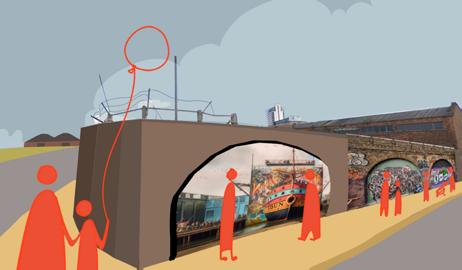
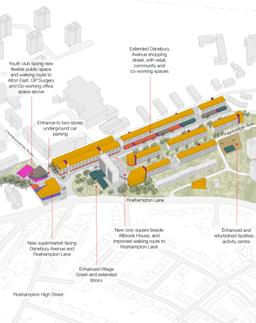
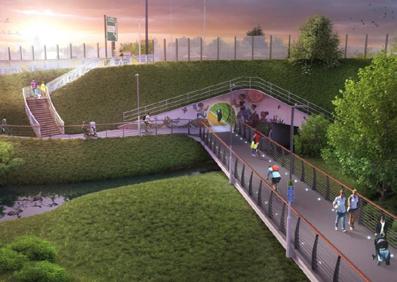
Redevelopment of site near St Joseph’s Church and Portswood Place These are the
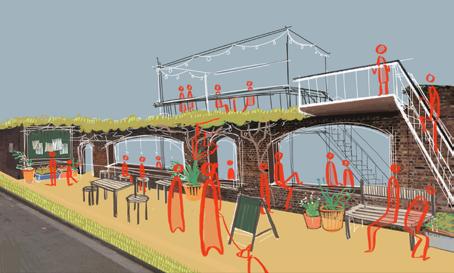

11 Programme Booklet 2022-2023 3 A F T E R
Axonometric view of the People’s Plan.
Superhighway
demand PREPARED FOR Just Space Workshop Just Space - Hackney Local Economy Energy Research
demolition
redevelopment
demolish
redevelop took
after various workshops
showing various possibilities to residents. In both places the spatial configuration of the sites made difficult making infill additions without compromising the quality of the built environment, and provided little flexibility to introducing many of the activities that residents and community organisations demanded, such as a large supermarket, workspaces, retail, cafés, health, youth and community facilities.
only two sites where
and
takes place. The decision to
and
place
and
local
Redevelopment of Site A near St Joseph’s Church, including a large supermarket, new homes, a café, a youth club, a GP surgery, co-working spaces and pods
for entrepreneurs and
businesses.
PROJECT 1 – Deptford
• Just Space organisation partner(s): Voice 4 Deptford (V4D)
• UCL student participant(s): Gabi Frank, Yvonne Kuo, Tan, Natalie Tan, Murun Li, Man Hin Sau
• Duration: ~4 weeks
• Location: Deptford Dockyard, SE8 3JF
Background:
• In 2014, the Convoys Wharf scheme was approved by then-Mayor Boris Johnson, who overruled Lewisham Council’s original decisions. The scheme, purported to deliver ~3500 new homes, sought to “regenerate” the Deptford Royal Dockyard.
• Since about 2017, V4D has organised within the local area against the regeneration, arguing that, among other things, the scheme fails to deliver adequate social infrastructure and affordable homes; ignores the views of local people; has skirted consultation processes; and avoids reference to local history and culture in the surrounding area.
• Indeed, V4D highlights the need for robust cultural planning and historic preservation, given the immense history of the area as one of London’s first royal docks and with its connections to complex historical phenomena such as the royal family, the transatlantic slave trade, and London’s industrial development.
• In May 2023, V4D members and Bartlett students collaborated to design interactions with the peripheral wall of Convoys Wharf, an “important element of V4D’s Re-vision of Convoys Wharf as a Centre for Innovation, Education and Research.” The existence of a planning permission for the scheme meant that nothing fundamental could be changed but this project was judged to be compatible with that permission.
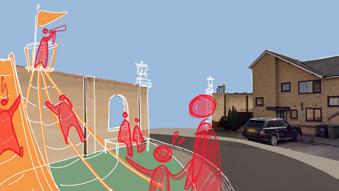


12 Just Space-UCL Knowledge Exchange
1 A F T E R 2 A F T E R 3 A F T E R
Outputs:
• In collaboration with V4D members, Bartlett students produced a vision and accompanying toolkit for the peripheral wall of Convoys Wharf, predicated on the notion of transforming the wall into a beacon of history, sustainability, and community engagement.
• The students’ proposal reimagined the wall as a backdrop for events, performances, gatherings, and activities; gateway of introduction, providing legibility and communication for the outside and the inside; a platform for panoramic views, displaying the site’s history; and demarcation for recreation and biodiversity. Indeed, the design intended to foster multidirectional interaction: parallel, above, point, and through.
• The toolkit included four elements: biodiversity & sustainability, through features such as reclaimed materials and habitat creation; heritage and culture, via aspects like murals and signage; social & community, with artistic, interactive, and playground pieces; and wellbeing & recreation, with particular attention to openings and entrances, viewing, and pockets of respite.
Reflections:
• In drawing from history and other prominent examples of innovative wall design – such as Folly Wall and Shoreditch Art Wall – the proposal successfully positioned the wall as an interface for interaction, rather than a barrier.
• V4D found the proposal, and the late-May workshop, to be “innovative and artistic,” highlighting “possibilities for the wall which will help to make the outline of V4D’s Re-vision [of the Conveys Wharf scheme] more tangible.”
• In this way, the proposal and toolkit helped foster and continue V4D’s longstanding and community-oriented thinking around the regeneration of the Deptford Dockyard.
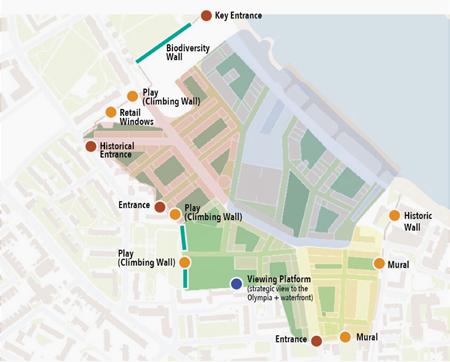
13 Programme Booklet 2022-2023
v 1 2 3 Entrance
PROJECT 2 – Alton Action
• Just Space organisation partner: Alton Action in Roehampton (LB Wandsworth)
• UCL student participant: Yasmin Hamde
• Duration: ~10 months
• Location(s): Alton Estate, SW15 4PS
Background:
• The Alton Estate was one of the definitive projects of the London County Council and its architects department in the 1950s and 60s, with Scandinavian and Corbusian influences. It provided high-quality social housing on a hilly, wooded site, previously occupied by spacious villas.
• Published in September 2021, The Alton Estate’s People’s Plan is a community-led proposal to improve the Alton Estate and the quality of life of its residents and communities in the face of demolition/replacement proposals.
• In 2020, Wandsworth Council had planned to enter a joint venture with private developers to demolish and redevelop part of the estate, increasing density four-fold. Residents and community groups came together and, with the help of UCL and through various co-design activities, elaborated a more socially, environmentally, and economically sustainable proposal.
• Drawing from co-design workshops, a survey, public events, presentations, and discussions with local residents, the Alton Estate’s People’s Plan provides more council homes and social infrastructure through retrofitting existing homes and proposing new homes and community spaces through infill development and roof extensions than the original proposed regeneration scheme.
• Working under the guidance of Dr Pablo Sendra, Bartlett students were tasked this year with creating more accessible presentations of the People’s Plan for residents who wish to learn more about it.
Outputs:
• Over multiple terms, Bartlett students transformed the original 155-page People’s Plan into a ~25-page summary document.
• The summary, which was completed in July 2023, retains the key details and structure of the People’s Plan, but presents them more concisely, accessibly, and
14 Just Space-UCL Knowledge Exchange
visually – with some minor updates.
• The summary document was presented to Knowledge Exchange participants –both from local Just Space organisations and UCL – during a May 2023 workshop, which included some brief discussion around the next steps and dissemination.
Reflections:
• Because the People’s Plan is not a statutory document, but instead a community vision that brings together the aspirations of local communities to improve the area, it is crucial that it is presented and communicated in a plethora of ways to accommodate different audiences with different amounts of time, educational backgrounds, and familiarity with the planning system and planning vocabulary.
Shops, community and workspaces in Danebury Avenue
• The balance between concision and oversimplification – or even omission – is difficult to achieve and requires iteration and collaboration.
One of the infill strategies is adding shops, community and workspaces on the ground floor attached to the maisonette blocks in the south side of Danebury Avenue. These maisonette blocks have a blank wall on the ground floor, which varies in height because the street is going down. In certain parts, there is a short podium that is accessed via stairs, which the People’s Plan proposes to demolish to incorporate these shops. This intervention would include bringing the access to the blocks to the level of the street and adding a lift. This will address the issue around accessibility that the blocks currently have, since they are not currently accessibility for people with limited mobility.
• 2022 local elections returned a Labour Council so there is an opportunity for new plans for Alton Estate’s regeneration – the original proposal was scrapped. Dissemination of the key vision and ideas from the People’s Plan, especially to local residents, is key.
The residents and community organisations highlighted in the workshops the need for more shops, workspaces and spaces for community groups. These spaces address these needs.
ALTON ESTATE PEOPLE’S PLAN
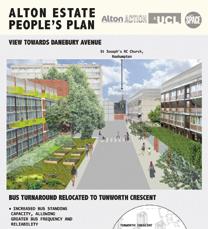
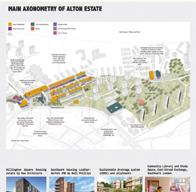





15 Programme Booklet 2022-2023
Produced by: In collaboration with: Project supported by: UCL Civic Design Exchange The Bartlett School of Planning Research England’s Higher Education Innovation Fund, managed by UCL Innovation & Enterprise WHAT IS YOUR VISION FOR ALTON ESTATE? Just Space and Alton Action Summary document
Collage showing the shops of Danebury Avenue on the right, the balconies, community gardens and private gardens on the left, and the roof extensions and infill developments.
PROJECT 3 – Thames Life
• Just Space organisation partner(s): Thames Life Community Development Trust
• UCL student participants: ~10
• Duration: ~10 months
• Locations: Thames View, Barking Riverside, and Every One Every Day Warehouse (IG11 0HQ) London Borough of Barking and Dagenham
Background:
• Thames Life is a community-based organisation seeking to develop leaders, “nurture relationships”, “exert influence” and “support enterprise” in the areas of and around Thames View and Barking Riverside. It was known as Thames Ward Community Project until the ward was abolished and a new name was required. The TWCP was initiated with National Lottery funds.
• Adopted as an Opportunity Area by the Mayor of London in 2014, this geographic area is “… one of the largest development sites in Europe, with 10,800 housing units planned for the Riverside development, part of a [Barking & Dagenham] Borough Corporate Plan (2018-2022) that seeks to build an additional 50,000 homes.” At the same time, the area has for many years been one of the most deprived areas in the Borough – ranking near the bottom of the LBBD Social Progress Index and with some of the highest rates of childhood obesity and deprivation in the country in its ageing council estates.
• Thames Life’s work in the area is wide-ranging, encompassing everything from running a Resident Planning Forum to promoting the reopening of the Ripple Nature Reserve (RNR) to hosting programming for young people around sport, community gardening, etc. Bartlett students, coordinated by Professor Michael Edwards and Marian Larragy, was initially brought on via the Knowledge Exchange to assist in research and advocacy around the reopening of the RNR, which sits alongside a National Grid switching/transformer node and has been closed to the public for some years.
• The Opportunity Area experiences many of the problems common to others in London, notably late delivery of social infrastructure, lack of social-rent housing production and a severe lack of transparency in governance.
16 Just Space-UCL Knowledge Exchange
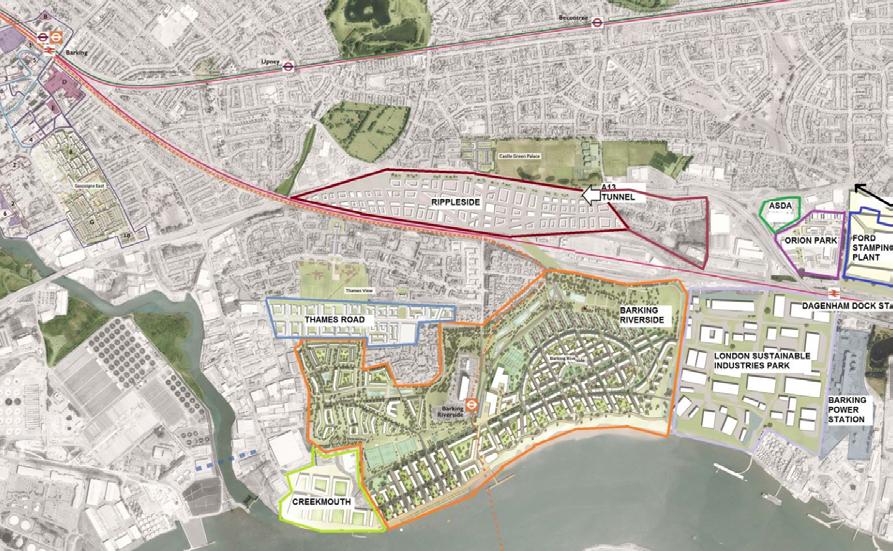
Outputs:
• During the initial period of engagement with Thames Life, Bartlett students worked to support efforts by a committee of local residents, organised and hosted by Thames Life, to reopen the ~10.1-hectare RNR. This included attending committee meetings, conducting supporting planning-related research (e.g. looking into freehold/leasehold questions), and proposing ideas grounded in rudimentary research for features that might foster an improved RNR. These proposals spanned many topics, including lighting, potential biodiversity-related impacts of cycle lanes, and play spaces for children.
• As students’ engagement developed over time, so too did their outputs. In the spring term, Thames Life asked for research specifically about social infrastructure delivery, Opportunity Areas, and preserving community spaces. These requests were built from existing concerns about the level of social infrastructure in the area even before the major development – there is only one GP for the entire area, for example – but were also precipitated by the Borough Council decision to stop leasing a large warehouse in the area (to Every One Every Day) for community programming.
17 Programme Booklet 2022-2023
• In response to these requests, and with the assistance of Professor Michael Edwards and Robin Brown, students attempted to provide research briefs about the requested topics for Thames Life – though these efforts were not organised until midway into the Summer term and thus were delivered piecemeal.
Reflections:
• Social infrastructure is key for local, existing communities in the midst of seismic change wrought by the planning system.
• Large developments – like the one being delivered through the Opportunity Area at Barking Riverside – present residents and community organisations with myriad and overlapping challenges. This development is an extreme case of the problems in most Opportunity Areas that governance lacks transparency and democracy.
• Community needs are constantly evolving and fast-moving – in a way that does not align necessarily with the cadence of student life for the purposes of the Knowledge Exchange. But students can also learn to navigate these time scales and offer to work across a longer time period developing knowledge and relationships which can contribute to groups.
• Listening to what communities and community-based organisations need, and setting clear expectations around how students and faculty might be able to help with those needs, is key to the success of the Knowledge Exchange Programme, especially for projects which are tied more to particular community groups or areas rather than to distinct projects or tasks.
• This year mentors avoided preparing precise work plans in advance so that students should have the crucial experience of tuning in to the turbulence of a fast-moving local society. This probably meant that some students never really felt useful, while others flourished.
18 Just Space-UCL Knowledge Exchange
doing now?
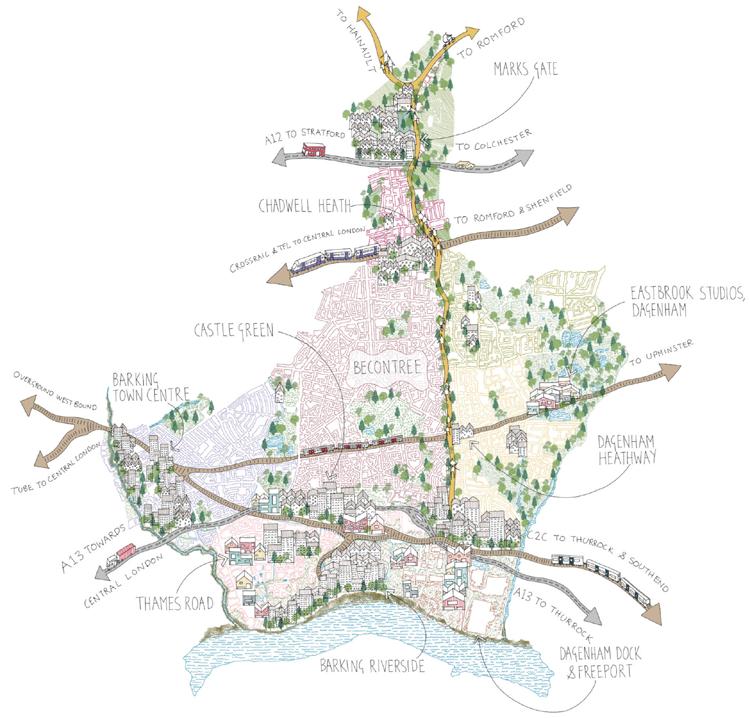
conservation & low impact the path much of the original landscape intact as possible adapted paths for walking and
March 2023
Barking & Degenham Illustration by BeFirst, 2021
Brian Lam | Dorothy Tsang | Fiona Duffy | Katharina Schwegmann | Ilaria Sutton | Marco Chan
Nature Reserve in Cotswolds
research
Cover illustration (BeFirst, 2021)
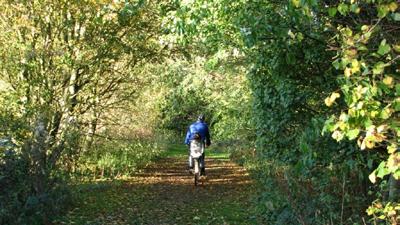
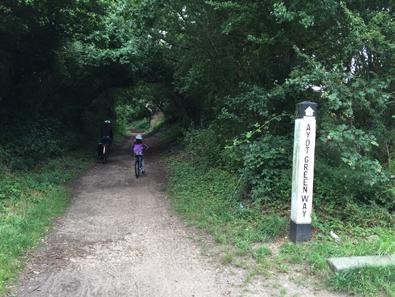
19 Programme Booklet 2022-2023 AN ISSUE-BASED STUDY WITH SPATIAL AND POLICY GUIDANCE
and
are
Nature Reserve in Cotswolds
Ayot Greenway in Welwyn Garden City
Nature Reserve in Costwolds
Ayot Greenway in Welwyn Garden City
PROJECT 4 – Hackney Local Economy
• Just Space organisation partners: Just Space Economy and Planning Group (JSEP)
• UCL student participants:Tracy Cheung, Wesley Wong, Bella Ariyani, Tianyi Lan
• Duration: Two terms
• Location: London Borough of Hackney
Background:
• JSEP aims to build capacity within the Just Space network to influence planning policy in London on economic issues. Beyond the corporate economic interests commonly represented in planning policy, London has a plethora of other, varied economic sectors and actors, “with many sources of knowledge about them, both within communities and in universities.”
• JSEP seeks to join up this somewhat disparate economic thinking, “supporting the participation in planning on economic issues by a greater diversity of groups and interests.” They focus on several key issues within this area: targeting growth, loss of employment land, affordable workspace, job quality, and local businesses and communities’ involvement in planning.
• Around 10 Bartlett students began research within JSEP’s focus area, choosing to focus on aspects of the local economy in the London Borough of Hackney.
Outputs:
• Individual and groups of students presented their research at a Just Space workshop in Fabruary 2023. The research covered three primary areas: community energy, Green New Deal (GND), and affordable workspace provision.
• Students’ energy research presented an overview of Hackney Light and Power, Hackney Council’s Energy company that was established in 2019. Through programmes like Green Homes and the Community Energy Fund, Hackney Light and Power aims to transform the local energy system, eliminate land transport emissions, and improve energy efficiency and reduce emissions of local businesses
20 Just Space-UCL Knowledge Exchange
in Hackney. The research also profiled Stokey Energy, a cooperative set up in Stoke Newington in 2019 that largely focused on solar panel installation projects. Finally, the energy research highlighted Banister House Energy, the first community-owned solar energy project in Hackney and the UK’s largest community energy project on social housing.
• Research about the Green New Deal in Hackney centred on the Hackney Labour Council’s 2019 pledge to deliver a GND that would transform the local economy. The research elucidated how Hackney’s Climate Action Plan is the main mechanism for actualising a GND in the Borough. Armed with £50 million to implement climate emergency measures, the most recent draft Climate Action Plan details plans for the circular economy, walkable/bikeable infrastructure, and green education. Significantly, the Green New Homes programme, started in 2020, funds insulation measures and low-carbon heat replacement for private housing in Hackney.
• Finally, the affordable workspace research explored Hackney’s Local Plan 2033 Policy 29: Affordable Workspace and Low-Cost Employment Floorspace, which requires that at least 10% of gross new employment floorspace should be low-cost employment floorspace and new affordable workspace on the site of the development (or provided offsite if onsite is not possible). After presenting some of the details of the policy – e.g. providers, spaces in council buildings, small businesses that are supported, etc. – the students noted how Hackney’s policy is more ambitious than many other London boroughs, especially by mandating the provision of reduced sub-market rent in perpetuity.
Reflections:
• Across all of the research, students noted that there were difficulties finding information about how these various programmes and policies have played out in practice since being introduced – and the impact they may have had on local communities. In this sense, there is a need to conduct interviews with local communities, government, and other relevant stakeholders to fill this gap.
• The research also raised the question of holistic approaches to the local economy or the lack thereof. In the GND work, for example, students noted how Hackney’s approach does not account for fundamental issues like cooling measures, programmes for businesses, and local production of green goods.
21 Programme Booklet 2022-2023
privately and not eligible for Council home or rented home from a registered social landlord This is be Council has a separate programme for improving the thermal efficiency of council homes
Benefit: grants (up to £10,000 for for owner-occupiers in receipt of a low income and with an EPC of D or up to £5,000 for owner-occupiers in receipt of a low income and with an EPC of D or below), lower energ CO2 emissions, and warmer homes and reduction of fuel poverty improved health for people who are vul cold and damp homes
Community Energy Fund (Launched in February 2022)
• Lastly, all three pieces of research had, or alluded to, suggestions to improve policy. To take the affordable workspace policy as a window into this, students suggested implementation of management regimes of affordable workspaces in Hackney (e.g. a list of organisations in need of affordable workspaces, so that the Council could help new developments match with suitable tenant organisations).
Aims: support community-led innovative energy projects benefiting Hackney – particularly schools and The total programme fund is £300,000. The Community Energy Fund grants target organisations with aims based and working in Hackney (registered charities, community and voluntary groups, co-operative equalities groups, and Social Enterprises Community Interest companies)
Benefit: The fund will help to reduce schools’ emissions and will help community groups to build kno delivering retrofit schemes, which they can share or use to deliver other projects in the borough. It will a schools to increase the level of student engagement on energy-efficiency measures as they are installed covers: capital costs (renewable installation cost, core costs (consulting fees, staff or office costs to suppo project costs (venue hire, project worker), and project management costs energy performance level to Band C. The Green Homes programme is aimed at people who
Energy Company
Light and Power
Hackney Light and Power is Hackney Council’s energy company established in 2019
Aims: transform the local energy system by generating clean energy eliminating land transport emissions reducing carbon emissions, supporting residents and businesses in energy efficiency across Hackney
Stokey Energy was set up in 2019 as a cooperative of local people and is aiming to achieve a zero carbon and climate-positive future in Stoke Newington Long-term goals include working with schools, theatres, sports centres and other public buildings to go green and develop a community that produces new employment and opportunities for everyone
With the support from the Mayor of London's London Community Energy Fund, Stokey energy is working on solar panel installation projects with Stoke Newington School, Rio Cinema, hackney empire and Mildmay Club
Bannister House energy co-op is the first community-owned solar energy project in Hackney and the UK’s largest community energy project on social housing Starting in 2015, Repowering London and Hackney Council have worked to develop this project alongside residents of the Banister House Estate
To purchase and install the solar panels, £149,500 was raised through a community share (131 individual investors)
The community can sell their energy produce to the National Grid The profits (20% of the net profit) are put into a community fund
Young people joining the internship programme gain training in energy efficiency and experiencing in installing solar panels with professional contractors (provided by Repowering London)
22 Just Space-UCL Knowledge Exchange
or rent t
own
Funds open for applications 1 November 2022 Deadline for submissions 31 January 2023 Assessment for Applicants February 2023 Successful Applicants Informed February 2023 Signed funding agreement March 2023 Upfront payment processed March 2023 Timeline for Community Energy Fund Applications
Hackney
Hackney
Stokey Energy
Bannister House Energy co-op
Green Homes programme increase an energy efficiency standard in private sector housing by providing the funding to raise household energy performance level Community Energy Fund support community-led innovative energy projects benefiting Hackney – particularly schools and students
PREPARED FOR Just Space Wo kshop PREPARED BY T any Lan t any an 22@uc ac uk Be a A yan be a a iyan 22@uc ac uk UCL students vo un eer ng for Just Space Just Space - Hackney Local Economy Energy Research
PROJECT 5 – Just Space Community-led Recovery Plan
• Just Space organisation partner: Just Space
• UCL student participants: ~10
• Duration: Term 1 and 2
• Locations: Cases from across London
Background:
• In response to the COVID-19 pandemic and the stark inequalities in Londoners’ health and living conditions it highlighted, Just Space led a series of online workshops, strongly supported by student facilitation, and dialogues between about 60 community organisations, particularly the smaller grass-roots groups, to begin developing a new ideas and policy proposals to address the growing and related crises of inequality, climate, and health. This work came together to produce the Just Space Recovery Plan, released in April 2022 and presented to the London Assembly later that same year in September.
• For this project, students delved into the Recovery Plan, eventually selecting particular policies or sections of the Plan in an attempt to answer the question: how can we build on the policies that comprise the Recovery Plan and move them towards realisation?
Outputs:
• Students focused on two particular areas of the Recovery Plan to develop and build upon: cooperative infrastructures and lifetime neighbourhoods.
• Student research about co-operative infrastructures – Policy 27 of the Recovery Plan – focused on shared libraries and community kitchens by way of examples to shed light on the realisation of the policy (“support the development of cooperative infrastructures, from the use of local contracting and supporting local business, through to housing co-operatives and platform co-operatives developed at the neighbourhood scale to build community resilience”). Through the use of case studies, including Zero Carbon Guilford Library and Granville Community Kitchen, the research offered guidance for establishing a strong cooperative infrastructure. Finally, it noted some of the benefits of this kind of infrastructure, both in the short and longer terms.
23 Programme Booklet 2022-2023
• The research about lifetime neighbourhoods – Policy 35 from the Recovery Plan –similarly took a case study approach, in this instance focusing on pubs as “Assets of Community Value” (ACV). After overviewing the idea of ACV and the various ways that pubs act as ACV, the research presented two different models which produce different kinds of neighbourhoods and ACV: New Municipalism and the Preston Model.
Reflections:
• In attempting to further develop and move towards actualising the Just Space Recovery Plan policies, students largely went to a more granular case study level to draw lessons from existing work that might pave the way, or provide lessons, for similar future work.
• Because many of the Recovery Plan policies are quite broad, students were able to take very different approaches to their mandate, which allowed to exploration of personal interests and utilisation of existing knowledge and skills; on the flip side, the challenge was in not drilling down too specifically so as to stray away from the originally intended policy idea.
• This work continues with a largely fresh cohort in 2023/4 in the lead-up to Just Space submissions to the next London Plan.
Contribution to the local economy






24 Just Space-UCL Knowledge Exchange
We want tobringjobsandeconomicvalueto thelocalsthroughthesharedlibraryandcommunitykitchen Thesharedlibraryandkitchenoperationwillbeentirelyrun andsupportedbythecommunity Fromthefrontdesktosupport roles Create job opportunities Staff running the library and kitchen and the handyperson scheme: assisting people with using the item and any enquiries related to the item. Cooperating with the local businesses offers business opportunities and increases their community exposure. (electrical appliance stores, maintenances and restaurants) Encourage DIY and training help to develop skills that widen locals' job opportunities. (Skills: maintenance, cooking) Recycling business Suppose the appliance is broken, but the components inside can still be used. In that case, the shared library can sell parts to an organisation, and the money can be invested in the library. Spaces for schools for cookery lessons, people who want to run food stalls but need equipment, and those wishing to be vendors on food delivery platforms. Space for events and businesses Grow their own food Support the community kitchen, joining the farmer's market, or working with a local supermarket to be the local supplier.
PART II: KNOWLEDGE EXCHANGE MODULES
In the 2022-2023 programme, three modules over the course of the year were available to Bartlett students that partnered with Just Space community organisations which were also part of the Just Space network. Each is highlighted in detail in the section below.
MODULE 1 – Morning Lane People’s Space (MOPS)
• Title: BPLN0033 Collaborative City Planning Strategies
• Term: Spring
• Coordinator: Elena Besussi
• Students: Around 50 students from the Urban Design and City Planning programme
Background:
• In 2017, Hackney Council purchased the land at 55 Morning Lane from Tesco £60m. The Council entered into an options agreement with the private developer Hackney Walk in 2019 with the longer-term aim of developing the land with a combination of retail, workspace, small supermarket, and housing. Very little information was produced about the conditions of the agreement between Hackney Council and the developer or about the developer’s intention for the area. The options’ agreement expired on 31 March 2022 with no proposal from the developer, who has now pulled out of a collaboration with Hackney Council –leaving the council open to rethink its proposals for the site.
• MOPS is a community campaign set up in response to this situation, comprised of people who live locally striving to ensure that future development is aligned with the needs of and responsive to residents. Having been established in 2019, MOPS conducted a survey in 2020 which collected more than 1300 responses – the findings of which were summarised in their Developing the Morning Lane site: Views from the Community report.
25 Programme Booklet 2022-2023
4
• MOPS’ focus moving forward is around establishing communication with the Hackney Council, which will likely prepare new planning guidance for the area now that the option agreement with Hackney Walk expires.
Output(s):
• Via a multifaceted and multistage assessment, 53 students worked in nine groups to develop interactive materials that (1) drew from data collection and analysis to design social impact indicators and social impact assessment tools aligned with the methodologies presented in the Just Space – DPU Social Impact Assessment in London Planning; (2) applied the social impact assessment tool on Hackney Council’s Local Plan; and (3) prepared planning guidance for the 55 Morning Lane area.
• Through site visits to 55 Morning Lane and Q&A sessions with MOPS members, the module required the co-production of planning knowledge: a process of collaboration between communities and future planners, with the intent to transform pre-existing understanding of the position and expertise that both parties represent.
• Hence, the UCL-MOPS collaboration produced a diversity of opportunities for contact between students and campaigners – opportunities for co-production, exchange of information, and collaboration.
Reflections:
• Students – alongside campaigners from MOPS – had to expose, understand, and critique the fundamental assumptions that undergird the concept of value in planning.
• At the same time, they wrestled with how data collected through community‐led surveys can be translated into place-based local social values and priorities.
• The 55 Morning Lane case study presents difficult questions about how place-based social values and priorities can be translated into indicators for the monitoring of social impacts of existing planning policies – like Hackney’s Local Plan – and future development proposals.
26 Just Space-UCL Knowledge Exchange


The nd Hac to uncover four core planning values that Hackney Council must ensure all future development provide utilizing the new proposed policy guidelines Societal costs stemming from lack of secure housing, unemployment, poverty, and poor mental health directly translate to financial liability for the council through NHS costs, antisocial behaviour, productivity, and more Community investment boosts economic and social activity, pride and use of public space, and resident retention which cannot be measured in economic terms but is invaluable to the vitality and future of Hackney as a place for everyone
Community group support
Continuity of existing Hackney character
Adequate community resources for population
in development proposals
community engagement
7. 55 Morning Lane. Conclusion strategy
27 Programme Booklet 2022-2023 S T R E N G T H E N C O M M U N I T Y A S E A T A T T H E T A B L E H O U S I N G R E T A I L O P E N & G R E E N S P A C E
C O N C L C O M M U N I T Y W E L L B E I N G A F F O R D A B I L I T Y D I V E R S I T Y A C C E S S I B I L I T Y Permanent social/affordable units Core Planning Values Additional family housing Building height limitations Protection of small businesses Sustainable Buildings Restriction of retal amalgamation Public open space for all
Transparency
Meaningful
G E 5 3 Group
History Site Analysis and Resource Gathering
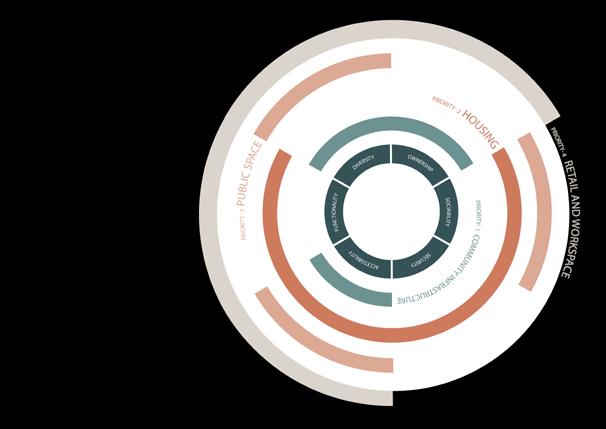
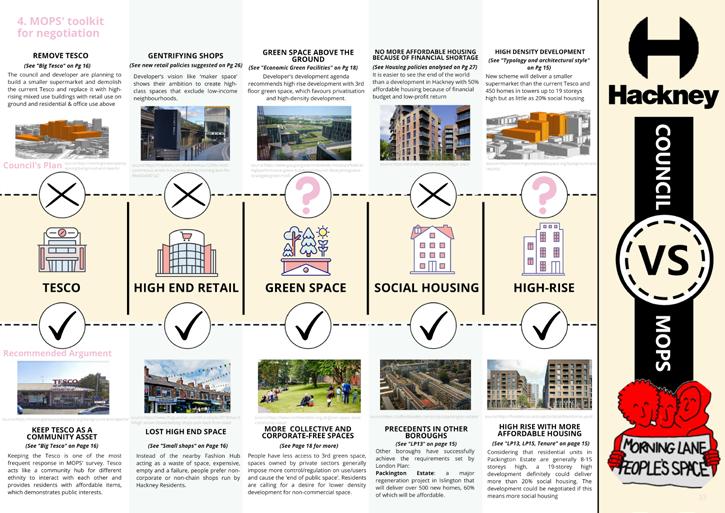
28 Just Space-UCL Knowledge Exchange Group 9 55 Morning Lane. MOPS’ toolkit for negotiation 2 8 SUMMARISING THE PRIORITIES COMMUNITY PRIORITIES AND SOCIAL VALUE 2 4 In the above analysis of the MOPS community survey we have found that there are six social values that overlap and underpin what the community views as important within the identified priorities The community value housing that is accessible to all, functionally and sensitively designed provided security for the long term and promotes a social sense of community The community value retail and workspace that is accessible for all local residents provides a diverse array of goods and services is owned by Hackney locals and is conducive to socialising amongst the community The community values public spaces that all can easily access that can support a diverse range of uses and are spaces that promote sociability The community value infrastructure that is accessible to all local residents offers a diverse range of services and uses that reflect local social needs, and is in the community s hands to own and manage HOUSING RETAIL AND WORKSPACE PUBLIC SPACE COMMUNITY INFRASTRUCTURE 2 C O M M U N T Y P R O R T I E S Group 6 55 Morning Lane. Summary of the priorities
MODULE 2 – Strategic Planning
• Title: BPLN0043 From Strategic Vision to Urban Plan
• Term: Spring
• Coordinator: Daniel Fitzpatrick
• Students: Around 70 from the Spatial Planning programme
Background:
• The module provided students with an opportunity to engage in a live plan‐making experience and aimed to equip them with a working knowledge of the potential of spatial planning and plan-making to deliver urban change that is attentive to the local needs of communities, in the context of the post‐COVID city and climate emergency.
• Students were tasked with applying the Just Space Recovery Plan as a vision and developing an urban plan from it for an outer London borough.
• Assisted by a series of relevant lectures from Just Space staff and member organisations, students were asked to (1) critically analyse and scope the Recovery Plan; and (2) prepare a spatial plan and planning guidance which builds on the Recovery Plan and students’ analysis of it.
Output(s):
• Each of the 13 student groups prepared detailed spatial plans for a chosen London borough, drawing from the themes and policies in the Recovery Plan, including planning context, vision, proposed interventions, and conclusions/ recommendations. Each group also prepared two-page summaries of their plans.
29 Programme Booklet 2022-2023
• In particular, the following groups worked on:
• Play strategy and co-creation spaces for Black and minoritised communities in Barnet, as well as a monitoring plan;
• Play streets and parks, Community Regeneration Charters, and critique of existing practice in Greenwich;
• Transport policy, specifically community street management, equitable road pricing, bus priority, and mobility hubs in Redbridge;
• Social value, economy policies at Kilburn High Road CID, and implementation plans in Croyden.
Reflections:
• The applicability and implementation of Recovery Plan policies in different boroughs and parts of London can take very different shape – responsive to local context, needs, and challenges.
• Many students focused on play and public space for recreational use – a topic that warrants further research and exploration in Just Space plans.
• The case studies that emerged from students’ assessments provide helpful data points for Just Space in terms of learning from existing programmes and policies, as well as developing a Directory of community stories.
30 Just Space-UCL Knowledge Exchange
implemented, we have applied the guidance of the Just Space Recovery Plan to the Borough to propose four key strategies to improve the sustainability of transport and the availability of equitable housing.
APlan to Enhancethe Sustainability and Accessibility ofHousing andTransportin
Reclaiming Redbridge: creating a connected, healthy and inclusive borou support a growing population
Redbridge

Reducing the dominance of the private rented sector and reclaiming empty homes to support those in need – Just Space Policies 19, 20 & 23
Fostering sustainable travel and healthy streets by reclaiming space from the private car and providing alternative options – Just Space Policy 36
Through an analysis of the current challenges facing Redbridge and the actions that are already being implemented, we have applied the guidance of the Just Space Recovery Plan to the Borough to propose four key strategies to improve the sustainability of transport and the availability of equitable housing
Redbridge has a fast growing population. Existing problems with housing affordability and availability, and traffic congestion and pollution, are likely to worsen over time.
This is the backdrop to four proposed interventions:
Reclaiming Redbridge: creating a connected, healthy and inclusive borough to support a growing population
1. Mobility hubs in strategic locations
2. Co-designed Local Authority Housing provision on key sustainable sites
Reducing the dominance of the private rented sector and reclaiming empty homes to support those in need – Just Space Policies 19, 20 & 23
Previous challenges with the implementation of LTNs and Mobility Hubs present room for improvement in engagement with residents. Housing unaffordability, poor provision of temporary accommodation, and lack of familysized units to serve the growing population are further key issues that must be addressed.
3. Providing a phasing structure to help community-led Healthy Streets initiatives
Fostering sustainable travel and healthy streets by reclaiming space from the private car and providing alternative options – Just Space Policy 36
4. Returning empty housing stock into active use for temporary accommodation.
The spatial elements of these interventions are set out in the map of Redbridge below.
Redbridge has a fast growing population Existing problems with housing affordability and availability, and traffic congestion and pollution, are likely to worsen over time.
Previous challenges with the implementation of LTNs and Mobility Hubs present room for improvement in engagement with residents. Housing unaffordability, poor provision of temporary accommodation, and lack of familysized units to serve the growing population are further key issues that must be addressed.

Investment
Interchange
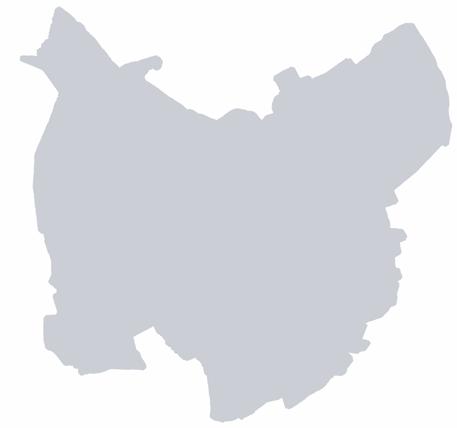
This is the backdrop to four proposed interventions:
1. Mobility hubs in strategic locations
2. Co-designed Local Authority Housing provision on key sustainable sites
3. Providing a phasing structure to help community-led Healthy Streets initiatives
4. Returning empty housing stock into active use for temporary accommodation.
The spatial elements of these interventions are set out in the map of Redbridge below.
Group 8. London Borough of Redbridge
31
g y g g g y g
Programme Booklet 2022-2023
Circle Line
Elizabeth Line
A12
Investment & Growth Area Interchange mobility hub Strategic mobility hub Local Authority Housing Sites Site 15 Site 120 Site 134 Site 74 N Key Location for Phased Healthy Streets Ilford Barkingside South
M11
Woodford
Circle Line
Elizabeth Line A12
M11
& Growth Area
mobility hub Strategic mobility hub Local Authority Housing Sites Site 15 Site
Site 134 Site 74 N Key Location for Phased Healthy Streets Ilford Barkingside
120
South Woodford
1. Tree Diagram
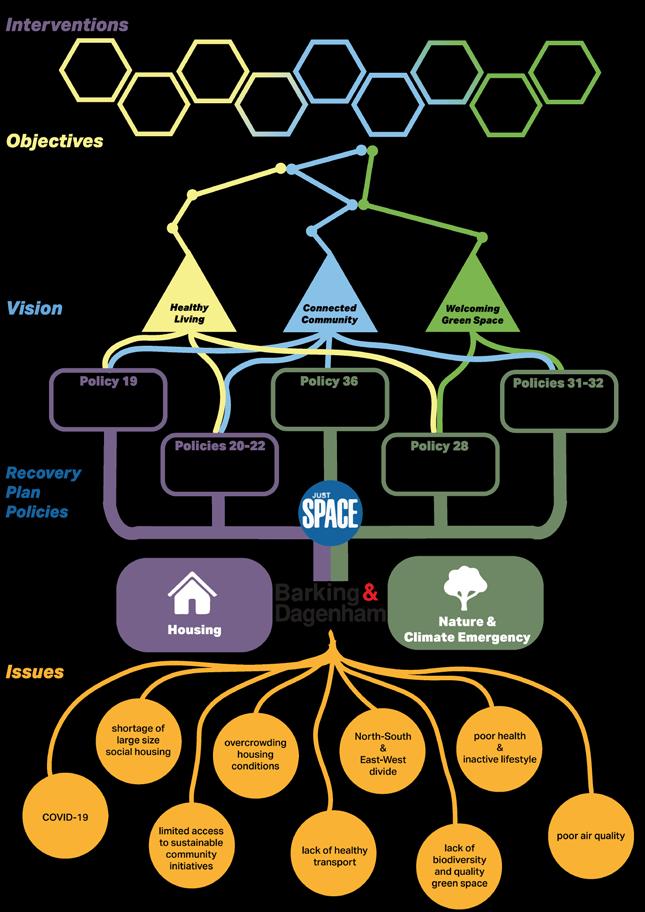
Group 3. Barking and Dagenham tree diagram.
32 Just Space-UCL Knowledge Exchange 4 Executive Summary
Figure
The interventions to the issues that are mentioned on the previous page have been spatialised across the borough, which can be seen in the following map:
HOUSING INTERVENTIONS
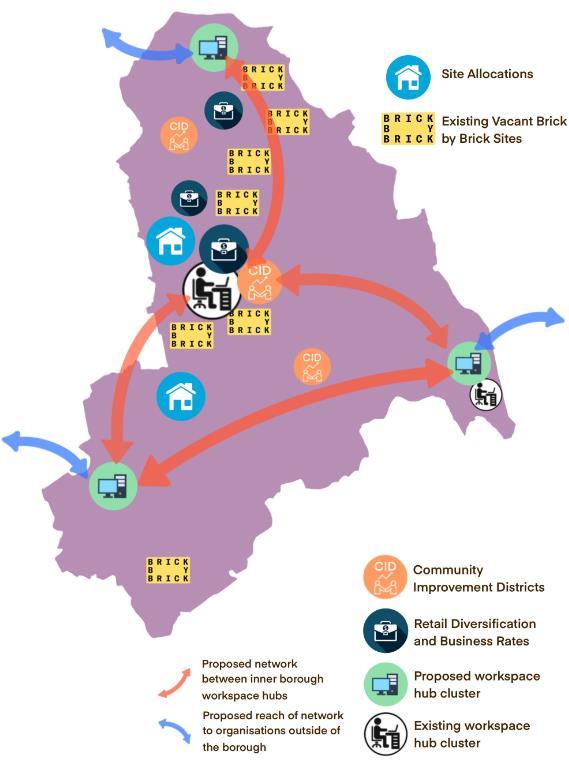
LOCAL ECONOMY INTERVENTIONS
Croydon Borough Council invites comments to be made on the proposals by email or in writing before the close of consultation at 5pm on Wednesday 24th May 2023 For further information, or for an accessible version of the consultation document, please contact Croydon Borough Council.
Group 12. Recovery Plan Croydon 2040.
33 Programme Booklet 2022-2023
CROYDON: CONSULTATION DOCUMENT
Greenwich Recovery Plan
Dear resident…
March 2023
Thank you for taking the time to read this summary of Just Space’s exciting vision for the Royal Borough of Greenwich.
Learn more and share your thoughts by visiting:
What is this Plan?
This Plan sets out a range of visionary interventions which can be applied in the Borough to grow a greater Greenwich.


The interventions are based upon the Just Space Recovery Plan, which set out a community-led vision of spatial change in London.
Who is Just Space?
Growing a Greater Greenwich Greenwich Recovery Plan
Just Space is an alliance of community-led grass-roots groups which harnesses local knowledge, experience and expertise with the aim to improve public participation in planning and ensure policy is fairer towards communities.
Our Mission Statement
Dear resident…
Thank you for taking the time to read this summary of Just Space’s exciting vision for the Royal Borough of Greenwich.
What is this Plan?
Our mission is to cultivate a thriving and resilient community in Greenwich. We aim to achieve this by redressing marginalisation through unlocking opportunities to those who cannot access them. The borough is not poor in social, natural and financial capital – and we propose redistributing this to allow all groups in society – age, ethnicity and location regardless – to participate in the development of the Borough.
Learn more and share your thoughts by visiting:
www.justspace.org.uk
Our Themes
This Plan sets out a range of visionary interventions which can be applied in the Borough to grow a greater Greenwich.
Our interventions develop upon the Just Space Recovery Plan’s themes of Fairness and Lifetime Neighbourhoods.
The interventions are based upon the Just Space Recovery Plan, which set out a community-led vision of spatial change in London.
Fairness (Policies 14-18)
Who is Just Space?
Under our plan, the borough’s residents and businesses would have the state meet them where they are. We propose doing this by providing services physically closer to people, giving help to access opportunities to those who need it, and allowing people to have a meaningful voice in the decisions which affect them. Through this, communities would be empowered and supported to take control of their neighbourhoods.
Our Mission Statement
Just Space is an alliance of community-led grass-roots groups which harnesses local knowledge, experience and expertise with the aim to improve public participation in planning and ensure policy is fairer towards communities.
Our reference to ‘growing’ does not refer to economic growth in the narrow sense – though this may be a co-benefit of the more just distribution of power and resources we propose. Rather, this plan intends to grow the borough’s social and community infrastructure (green infrastructure, transport, high streets, governance, and skills).
Our mission is to cultivate a thriving and resilient community in Greenwich. We aim to achieve this by redressing marginalisation through unlocking opportunities to those who cannot access them. The borough is not poor in social, natural and financial capital – and we propose redistributing this to allow all groups in society – age, ethnicity and location regardless – to participate in the development of the Borough.
Unequal spatial and social distribution of green space, with concentration in large expanses of

Explores the needs for local authorities to investigate existing racial inequalities and patterns of deprivation, ensure inclusivity in policy participation and establishing digital hubs for young people.
Lifetime Neighbourhoods (Policies 25-27)
Our Themes
Covers the incentive to introduce 15-minute cities and to invest in local people and services. Requires the mapping and auditing of local infrastructure and community assets
Our interventions develop upon the Just Space Recovery Plan’s themes of Fairness and Lifetime Neighbourhoods.
Fairness (Policies 14-18)
Under our plan, the borough’s residents and businesses would have the state meet them where they are. We propose doing this by providing services physically closer to people, giving help to access opportunities to those who need it, and allowing people to have a meaningful voice in the decisions which affect them. Through this, communities would be empowered and supported to take control of their neighbourhoods.
and further afield, including by active

Concern that new spatial frameworks and opportunity areas are not designed for local residents

Concern not all residents' voices are reflected in the proposed change and will benefit from anticipated benefits
Our reference to ‘growing’ does not refer to economic growth in the narrow sense – though this may be a co-benefit of the more just distribution of power and resources we propose. Rather, this plan intends to grow the borough’s social and community infrastructure (green infrastructure, transport, high streets, governance, and skills).
Intervention 1:
Rebalancing Green and Social Infrastructure
Unequal spatial and social distribution of green space, with concentration in large expanses of park
Poor north-south connectivity within the borough and further afield, including by active travel
Intervention 1: Rebalancing Green and Social Infrastructure
Intervention 2: Activating High Streets and the Local Economy
New 'lifetime neighbourhoods' lacking character
Lack of economic support for local businesses
Local high streets are lacking activity
Intervention 2: Activating High Streets and the Local Economy
Explores the needs for local authorities to investigate existing racial inequalities and patterns of deprivation, ensure inclusivity in policy participation and establishing digital hubs for young people.
Lifetime Neighbourhoods (Policies 25-27)

Greenwich underperforms London’s average for no qualifications at age 19 Stark wealth divides, meaning disadvantaged communities can be excluded from educational, economic and
Covers the incentive to introduce 15-minute cities and to invest in local people and services. Requires the mapping and auditing of local infrastructure and community assets
4: Employment, Education and Skills
Concern that new spatial frameworks and opportunity areas are not designed for local residents

Concern not all residents' voices are reflected in the proposed change and will benefit from anticipated benefits
Intervention 3: Enhancing
Greenwich underperforms London’s average for no qualifications at age 19
Stark wealth divides, meaning disadvantaged communities can be excluded from educational, economic and digital opportunities
34 Just Space-UCL Knowledge Exchange Group
Growing a Greater Greenwich.
4.
www.justspace.org.uk
Intervention
Intervention
3: Enhancing Governance and Democracy
park
New 'lifetime neighbourhoods' lacking character Lack of economic support for local businesses Local high streets are lacking activity
Growing a Greater Greenwich: Greenwich Recovery Plan Greenwich Peninsula Our 7-Step Strategy 1. Build strong community partnerships 2. Foster economic growth 3. Promote social equity 4. Preserve natural resources 5. Develop walkable and bikeable neighbourhoods 6. Support education 7. Foster a sense of community BLITT-TRAIN Woolwich Rd Blackwall Tunnel The O2 Charlton Riverside Westbourne Park station Charlton station A102 Maze Hill station North Greenwich station Greenwich Park Maryon Park Blackwall Ln to Canning Town to Kidbrooke and Eltham Intervention 1: Rebalancing Green and Social Infrastructure 1.1 Play Streets Is there a lack of free play space for children and young people in your area? • Once a week a select number of streets will be closed to any through traffic to allow residents to use the street for recreational activities • Residents will be able to plan and organise events, bringing communities together. • Play streets benefit children’s health and develop their social skills and build connections within the community. 1.2 Community gardens & allotments Can you readily access a community green space? • An increase in the number of community gardens and allotments will give a greater number of people access to a green space they can enjoy. • Gardens maintained by the community with food produced in allotments. 1.3 Play parks & outdoor gyms Do you feel that there are few play parks and outdoor gyms where you live? • Conducting surveys will allow the Council to see where there are gaps and a need for play parks in Greenwich • Increasing the number of play parks gives a greater number of people access to play Intervention 2: Activating High Streets and the Local Economy 2.1 High-street amenities and community service audit Are the right amenities available on your local high street? • An annual community-based audit has the potential to be carried out on every high street in Greenwich. • It will highlight footfall; amenities needs and street health so that residents are able to understand their local high street. 2.2 Establishing multi-use on the high street Are you lacking night/evening time activities within your neighbourhood? • An increase in night-time uses could be possible by creating a live register that identifies high street units where a secondary occupier is available. • The local authority could be encouraged to drop business rates and give financial support to incentivise businesses into the scheme. 2.3 Supporting independent businesses, BIDs and cooperatives What can we do to support independent local businesses? • The Council could provide loans, grants and subsidies to business rates for start-ups to empower local independent businesses. Start-up business programmes will be provided for support in the early stages and local businesses will also be provided
Poor north-south connectivity within the borough
travel
digital opportunities
Governance and Democracy Intervention 4: Employment, Education and Skills
MODULE 3 – Civic Design
• Title: CPD Civic Design
• Term: Spring
• Coordinator: Pablo Sendra
• Students: Chin Ho, Gopika Praveen, Saba Zavarei, Le Hai Ngoc Doan, Ahlam Althunayan, Sagarika Dias, Daniel Pitt, Dimitrios Giannelos, Harry Zimmerman, Omar Corona, Selenge Erdenebayar, Sinéad Nicholson, Anna Gomez Libera, Kejun Leng, Alysha Leung, Leonie Zeuner, Clelia Cothier, Kavian Kulasabanathan, Jonathan Nylander, Giulia Pagliarini Lanzuolo, Ana Paula Rojas Cosp, Luis Sáenz García, Gabriel Berti, Rod O’Donnell, James Wynne, Gemma Drake, Harry Regan.
Background:
• Civic engagement is now considered to be a key process in urban design and planning practice. Delivered in collaboration with community groups across London, the module helps students from a range of professional backgrounds learn and experience how to work in collaboration with communities.
• The Spring 2023 module partnered with resident groups from Juniper Crescent and Gilbey’s Yard, neighbouring London housing estates that voted down the ballot on the redevelopment plan proposed by their landlord One Housing Group. Students were tasked with coming up with improvements to the balloting process – especially those that could move beyond ‘no’ ballots, as GLA balloting guidance provides little detail for the next steps after an unsuccessful (‘no’) ballot vote for proposed regeneration.
Output(s):
• In collaborating with residents from either Juniper Crescent or Gilbey’s Yard during the end-of-term four-day intensive face-to-face workshop, each of the six student groups produced reports relating to the failed ballot, including both analysis of it as well as proposals and recommendations for improving the GLA balloting process moving forward.
• The groups had slightly different foci and took different approaches, as demonstrated by the examples below:
35 Programme Booklet 2022-2023
• After the ‘no’ vote: key solutions for the balloting process, rethinking the balloting process, and the ballot checklist.
• Juniper Crescent: priorities for regeneration and three scenarios for the future (refurbishment and retrofit, partial demolition and redevelopment, and full redevelopment with a new masterplan);
• Propositions for next steps for Gilbey’s Yard: building community engagement, alternative community governance mechanisms, and localisation of planning regulation;
• Fairness of the ballot process and proposals to improve it through principles of fairness (transparency, conviviality, accountability, impartiality, level the playing field).
Reflections:
• Students were able to think critically about both live and controversial planning policy questions – and to do so in collaboration with residents who just went through, and are continuing to go through, that process.
• While the topic of analysis and solutions involved challenging questions and concerns – including, for example, fear of displacement, disempowerment, and undemocratic decision-making – it also allowed students to ideate about a critical issue in 21st century London urban placemaking.
44
expressed dissatisfaction with the slow response to maintenance issues with buildings; in certain cases, it might take over a month to receive a response In our opinion, creating a property management office inside the community centre that serves as a go-between for the locals and the housing developer would be able to offer a transparent and quick procedure for delivering a clean and safe environment for the locals
b Three scenarios for the future of Juniper Crescent
i First Scenario: Refurbishment and Retro
We also support the establishment of a community garden at the location since it may not only lessen the site's environmental effect but also motivate locals to be more active physically and socially and strengthen neighbourhood ties It is an area with the ability to strengthen the bond between people and the environment while also being advantageous to both Juniper Crescent residents of all ages may benefit from their community garden s ample supply of fresh produce while learning more about sustainable agriculture
ties but also prov de an additional public
iii Third Scenario: Full Redevelopment With a Different Masterplan 42
for
physical amenities for adults or the elderly to use in the open space Therefore, in addition to the existing green space and children s area, we intended to create an indoor community centre that would not only help strengthen community ties but also provide an additional public gathering space for locals during inclement and cold weather
inclement and cold weather iii Third Scenario Full Redevelopment With a Different Masterplan
ii Second Scenario: Partial Demolition and Redevelopment
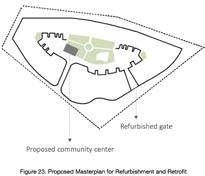

In our second proposal, we suggest redeveloping the area with minimal demolition and relocation of the residents of Juniper Crescent The proposal's primary goal is to provide an indoor communal space for local inhabitants of all ages while increasing the supply of social housing In a nutshell, we want to raise the site s population density and make Juniper Crescent s sense of community stronger As stated above, we understand how crucial it is to create a community place where the residents may congregate throughout the year We aim to

36 Just Space-UCL Knowledge Exchange
40 b Three scenarios for the future of Juniper Crescent i First Scenario: Refurbishment and Retrofit In our first scenario we would like to put greater emphasis on renovation and retrofitting in order to maintain the site s original visual and prioritise the well-being of the residents at Juniper Crescent We acknowledge demolition on the site would have a significant negative impact on occupants, both physically and psychologically due to the uncertainty surrounding their ability to leave and financially due to the increased costs Therefore, in our first scenario, we suggest that the existing condition be improved by refurbishing the impacted apartments and utilities as well as providing individuals with a multipurpose indoor communal space 42 expressed dissatisfaction with the slow response to maintenance issues with buildings; in certain cases it might take over a month to receive a response In our opinion creating a property management office inside the community centre that serves as a go-between for the locals and the housing developer would be able to offer a transparent and quick procedure for delivering a clean and safe environment for the locals We also support the establishment of a community garden at the location since it may not only lessen the site s environmental effect but also motivate locals to be more active physically and socially and strengthen neighbourhood ties It is an area with the ability to strengthen the bond between people and the environment while also being advantageous to both Juniper Crescent residents of all ages may benefit from their community garden s ample supply of fresh produce while learning more about sustainable agriculture
Second
al l s all se ty g , ty place where the residents may congregate throughout the year We aim to
Group 4 Scenarios for the future of Juniper Crescent. Students: Anna Gomez Libera, Kejun Leng, Alysha Leung, Leonie Zeuner
ii
Scenario: Partial Demolition and Redevelopment
no
44 no
elderly to use in the open space Therefore
green space
children
area
create
not on y help strengthen community
40
physical amenities for adults or the
in addition to the existing
and
s
we intended to
an indoor community centre that wou d
gathering space
locals during
In our first scenario we would like to put greater emphasis on renovation and retrofitting in order to maintain the site s original visual and prioritise the well-being of the residents at Juniper Crescent We acknowledge demolition on the site would have a significant negative impact on occupants both physically and psychologically due to the uncertainty surrounding their ability to leave and financially due to the increased costs Therefore in our first scenario we suggest that the existing condition be improved by refurbishing the impacted apartments and utilities as well as providing individuals with a multipurpose indoor communal space
fit
Our principles of fairness are as follows:
3. Governance
As explained in the next sec�on, One Housing needs to be supervised by a governing body that makes sure they follow through with the promised steps of project execu�on during the rehousing process. One Housing must make sure that all residents have assigned housing guides to help with the transi�on and must provide writen documenta�on along every step of the way.
4. Community
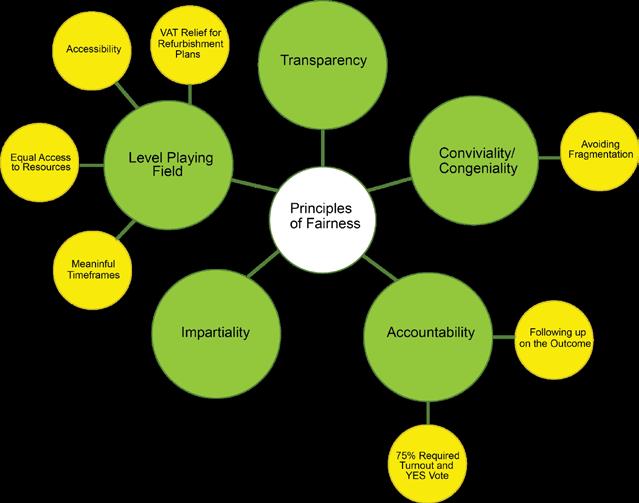
One Housing must also implement a Priority List where residents get to choose their homes based on their peripheral but significant life needs such as medical, educa�onal etc. This would ensure that the residents are able to build their community in a natural and organic way once again.
Group 6. Proposal to improve the Ballot process. Students: Gabriel Berti, Rod O’Donnell, James Wynne, Gemma Drake and Harry Regan.
4.2. Rethinking the Ballot Process – The Proposal
These principles will contribute towards a genuine process of co-creation. Much of our discussion has demonstrated how the knowledge of residents was not recognised or valued, even during the consultation stage. Thus,

The above diagram depicts the proposed series of events to rethink the Ballot process. The mayor’s current policy requires alternatives to be considered and demolition to be pursued only as a last option. However, it does not specify any details of how this process should be considered. In addition, the GLA is not placing a limit on the number of ballots that can be held on an existing estate. It has led to the situation that One Housing can repeat the ballot after a NO vote until a positive ballot is obtained and residents are faced with a choice of regeneration or continued decline in living conditions and they cannot write down their opinion about other
Group 2 Collective intelligence methods and rethink the ballot process. Students: Le Hai Ngoc Doan, Ahlam Althunayan, Sagarika Dias
37 Programme Booklet 2022-2023 discussions with residents, forming a framework that we think could shape and direct necessary changes to the ballot process
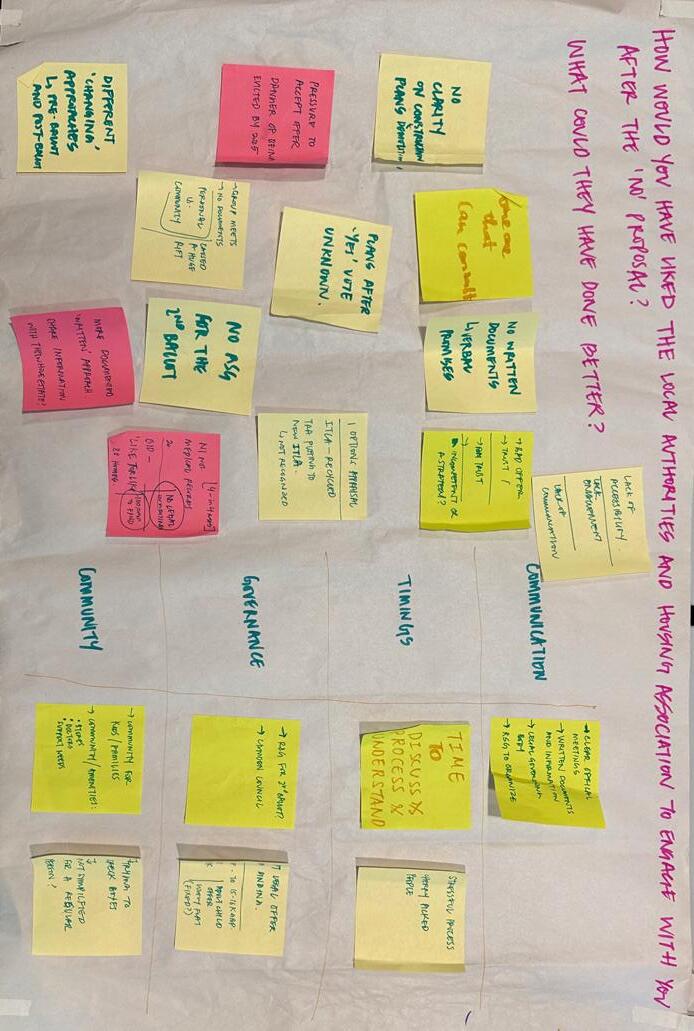
Group 2 Collective intelligence methods and rethink the ballot process. Students: Le Hai Ngoc Doan, Ahlam Althunayan, Sagarika Dias
understand elements that should be improved to make the ballot process more fair, transparent and sus tainable.
38 Just Space-UCL Knowledge Exchange

39 Programme Booklet 2022-2023
Group 2 Collective intelligence methods and rethink the ballot process. Students: Le Hai Ngoc Doan, Ahlam Althunayan, Sagarika Dias
unwanted redevelopment plans (see Figure 7). In the case the One Housing decides to present a second ballot, concrete and actionable proposals, such as Alton Estate’s People’s Plan, provides the “no” option with an inspiring vision beyond just carrying on with repairs and essential maintenance (One Housing, 2020).
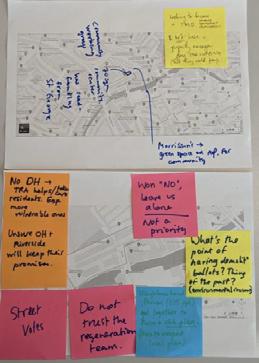

The co-designed vision also includes changes to give the playground an uplift as well as installing two locations of bike storage. The motivation behind bike storage was to improve both health and environmental aspects in the community. There is also a community centre being built in the Camden Good Yards development. Gilbeys Yard residents expressed a wish to be able to run and manage the new community centre, thus making it an extension of the community and allowing residents across Juniper Crescent, Camden Good Y ards and Gilbeys Yard to connect. Residents also mentioned a desire to install CCTV cameras and fences to deal with anti-social behaviour and other unwanted intrusions to the community. While these measures would increase the sense of safety among some com munity members, there is also a risk for other residents to feel an intrusion on privacy and negatively impacting the aesthetics of the estate. Alternative measures for reducing unwanted behaviours in the neighbourhood might look like the installation of b right outdoor lighting with motion sensors in the playground and edge-areas of the estate to make it less attractive spaces for antisocial behaviour in evening and night time.
During the co-design workshops, insights and ideas were generated in conversation between us and residents. These ideas, most coming from residents themselves, were written on postit notes and also drawn onto printed maps (see Figure 5). Through an iterative analytic and synthetic process, we created three categories that relate to the community vision: community care, community space and community agency. The following subsections will describe each of these in further detail.

6: A map of Gilbeys Yard highlighting improvements that could be made to the estate.
Group 5 Gilbeys Yard. Students: Clelia Cothier, Kavian Kulasabanathan, Jonathan Nylander, Giulia Pagliarini Lanzuolo, Ana Paula Rojas Cosp, Luis Sáenz García.
Finally, regarding the houses and living spaces, there were suggestions for ‘house swapping’ between residents. As space needs change throughout one’s life, there is an opportunity for families to swap houses within the community. For instance, a couple whose children have moved out and gained stable housing, there is less need for space. If at the same time, a
40 Just Space-UCL Knowledge Exchange
Figure 5: Maps and canvases used in co-design workshops to capture Gilbeys Yard residents' existing plans and vision for their community.
16
Figure
5
Beyond specific reflections for each project and module individually, the 2022-2023 Projects and Modules as a whole provide several key programmatic learnings that could help tailor and improve the Just Space-UCL Knowledge Exchange programme moving forward.
1. By having many Bartlett School of Planning student participants, and indeed many who were flexible and ready to get involved in a variety of ways, the programme as a whole was able to accommodate new projects, new research asks, and new avenues for involvement that arose throughout the year.
2. There was a loss of student participation over the course of the year – what started off as large and eager numbers dwindled in many of the projects as time went on. More attention could be paid to the ideal number of student participants in each project (and module), as well as mechanisms for preventing loss of interest.
3. The projects and modules that were more specifically tailored around predetermined tasks, usually requested by Just Space or the community organisation involved, produced more concrete and tangible outcomes and final products.
CONCLUSIONS: PROGRAMME LEARNINGS
4. More detailed guidance might be delivered to student participants at the start of their participation to outline how much participation should be guided by their own personal interests versus by what is needed by Just Space or the individual community organisations. This can be improved by being clear about the range of projects students can get involved with and in what way.
5. Relatedly, more attention might be paid to the method(s) of allocating student participants into projects. Some work, like that in Barking Riverside, might be better served with more student participants, given the scope of change taking place there and the enormous planning processes and decisions being taken. Of course, student interest and preference is very important – and probably impact project attrition – but so too is the potential to make a difference with increased UCL students and resources for some of the most pressing and large-scale projects.
41 Programme Booklet 2022-2023
Social Eco-System Dance Model
Figure 6. Hybrid systems in the shared social eco-system
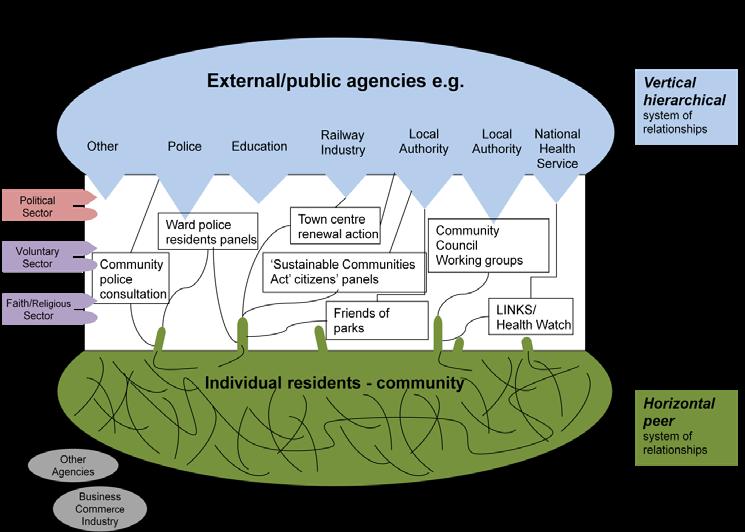
Social Eco-System Dance Model - Hybrid systems in the shared social eco-system. Conn, 2011.
It is worth noting that aspects of the vertical hierarchical and horizontal peer distinctions may find some expression also in the world beyond community engagement, with some similar and some dissimilar effects:

Interactions between commercial organisations and their customers.
The fluid free association networks at horizontal peer levels within corporate organisations in both public and commercial sectors.
Communities of practice, transcending organisational boundaries, as noted earlier.

42 Just Space-UCL Knowledge Exchange
10
12
lens can illuminate many aspects of the roles of these sectors, in the working of community engagement.
Public presentation of the People’s Plan at St Joseph’s Church. July 2021. Photos by Alton Action
Public
presentation of the People’s Plan at St Joseph’s Church. July 2021. Photos by Alton Action.
systems
Furthermore, some important lessons can be drawn from the programme:
1. The support from the Bartlett School of planning is important. To have a space that is a site for pedagogic experimentation and engaged learning is important, especially as the imperatives for planning and urban design tend to be geared away from community groups and citizens involvement and demands.
2. The collaboration has built on years of work with Just Space as well as other groups within and beyond their network of planning groups aim to make this knowledge exchange mutually beneficial for these groups also who gain from the skills, expertise and energy of our current students; but also help shape these networks and show that university-community collaborations can be mutually fruitful finding new ways in which institutional forms of community engagement as currently practiced in university settings can be shaped.
3. Effective engagement with community groups as well as wider social movements will continue to provide important lessons for future planning work and developing solutions to intractable urban problems. The Knowledge Exchange has been a way to challenge some of the hierarchical and competitive university structures and find more compatible ways of working with the
organisational forms of community groups.
4. The Knowledge Exchange offers a “space of possibility” which draws both on the autonomy of community groups and the formal structures and resources of universities. This is an example of an intermediary organizational form between the university and community groups, which has allowed to some extent the decentring of power involved in the production of knowledge and the development of genuinely collaborative structures (see Conn 2011; Bell et al. 2022; and Sendra, 2023).
5. The Knowledge Exchange as programme is not just about acknowledging the potential for exchange in collaborations between planning students and communities, but it is also an opportunity to explore ways in which we can learn from and with eachother; using and appreciating different forms of planning knowledge, epistemic framings, and seeing how these different knowledges can be used in both teaching, research or advocacy contexts.
43 Programme Booklet 2022-2023
44 Just Space-UCL Knowledge Exchange
SOURCES
Alton Estate People’s Plan, 2021. Retrieved from https://pablosendra.com/ucl/altonestate-peoples-plan/
Bartlett School of Planning, CPD Civic Design. Retrieved from https://www.ucl.ac.uk/ bartlett/planning/programmes/cpd-civic-design
Bell, S., Lee, R., Fitzpatrick, D., & Mahtani, S. (2021). Co-producing a community university knowledge strategy. Frontiers in sustainability, 2, 661572. Retrieved from https://www.frontiersin.org/articles/10.3389/frsus.2021.661572/full
Conn, E. (2011). Community engagement in the social eco-system dance. Moving forward with complexity, Litchfield Park, AZ: Emergent Publications, 285-308. Retrieved from https://www.london.gov.uk/sites/default/files/ad_24_community_ engagement_in_social_eco-system_dance.pdf
Cooperation between Just Space and universities. Retrieved from https://justspace.org. uk/links/universities/
Morning Lane Wesite. Retrieved from https://morninglanepeoplesspace.org/getinvolved/
Just Space: Assemply is listening, (September, 2022). Retrieved from https://justspace. org.uk/2022/09/26/assembly-is-listening/
Sendra, P. (2023). The ethics of co-design. Journal of Urban Design, 1-19. Retrieved from https://www-tandfonline-com.libproxy.ucl.ac.uk/doi/full/10.1080/13574809.2 023.2171856
Social Housing Action Campaign (September, 2022). Retrieved from https://shaction. org/2022/09/07/victory-for-ohg-tenants-in-regeneration-battle/
UCL Working with Just Space (October, 2023). Retrieved from https://ucljustspace. wordpress.com/
Wandsworth Times (October, 2022). Retrieved from https://www. wandsworthguardian.co.uk/yoursay/news/23015675.alton-estate-wandsworthsaved-immediate-demolition/
45 Programme Booklet 2022-2023

46 Just Space-UCL Knowledge Exchange JUST SPACE-UCL KNOWLEDGE EXCHANGE 2022-2023 Programme



















































